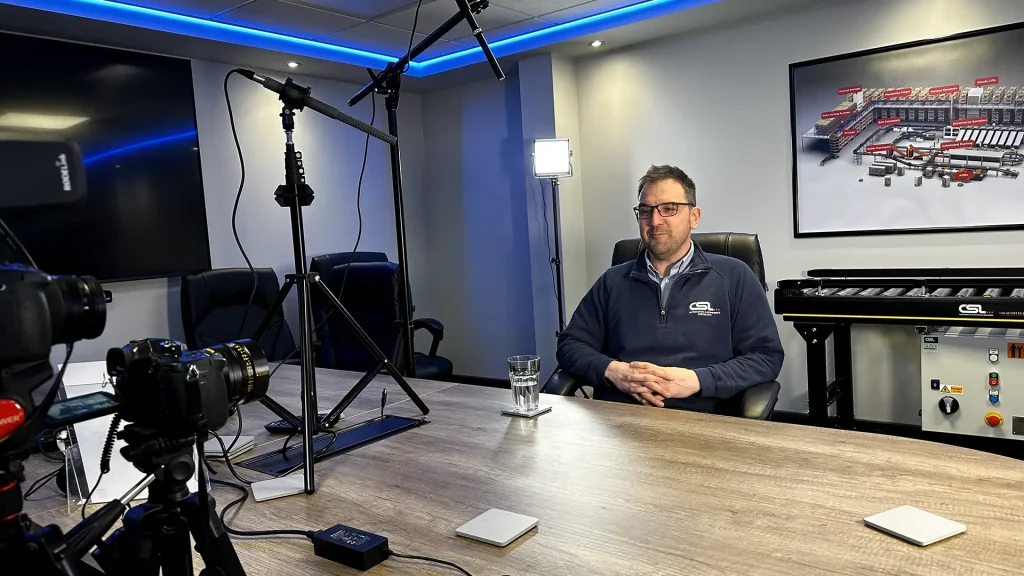Evaluating ecommerce peak periods
Darren Needham, Business Development Manager at CSL, talks about monitoring and evaluating ecommerce peak periods in warehousing and distribution and how these challenging times of the year should be analysed and reviewed to ensure ongoing improvement.
Automation can be the difference between a successful and a stressful Peak period, and CSL are on hand with over 25 years of expertise and experience to advise on conveyors and automated materials handling equipment that can improve and streamline your processes, from designing and installing new systems, modifying and updating existing ones or servicing and repairing your trusted conveyors and machinery to ensure they get through Peak periods without breakdowns or interruptions.
Watch the video here, or read the transcript below. Don’t hesitate to contact us if you have any questions or need advice on automation for your warehouse or distribution centre.
Webinar Transcript:
“Hello, my name’s Darren Needham and I’m the business development manager for Conveyor Systems Ltd. It’s a pleasure to welcome you all today to today’s session on monitoring and evaluating peak periods and also the potential for optimising operations during peak via the use of automation. I just wanted to use the next sort of 15 or 20 minutes or so to speak about peak periods and the potential of fluidity and multiplicity throughout the year.
And I’m hoping that this may act as a reminder or a refresher on things to consider both during and post peak and to potentially introduce how consultants and systems integrators such as ourselves can help you to evaluate and assess the positive aspects of the season, whilst also suggesting ways that operations could potentially be made more efficient. So the world of e-commerce and its logistics is rapidly evolving, we’re witnessing both opportunities and challenges at an unparalleled rate, whether you’re an industry veteran or a newcomer, understanding and adapting to this landscape is pivotal for both growth and sustainability.
Peaks in demand, as most of you already know, don’t follow a one-size-fits-all pattern. They vary depending upon the industry and can range from events like Valentine’s Day, summer sales, and promotions to massive shopping events like Black Friday, Cyber Monday and Christmas periods, with many businesses dealing with multiple peak periods during the calendar year.
Yet even with our familiarity with these peaks, modern challenges in e-commerce are pushing our traditional systems to the very limit. Issues like supply chain interruptions, rapid shifting consumer behavior, or even the global effects of just a single influencer’s product endorsement. This can cause unexpected surges in demand. So with businesses needing to be more flexible and adaptable to cope with these together with the speed in which these seasons come and go, it’s essential that we evaluate our performances, ready to do the next one bigger and better.
During these peak periods, we face a spectrum of issues; supply chain disruptions can block our product flow, for example, labor shortages or even worse, poor quality labor can affect the speed of our operations. And with the potential surge in demand, there’s also an increase in expectations from the consumers themselves, who are more and more demanding faster deliveries and a more responsive service.
The key to success lies in preparation and evaluation. As we navigate these peaks, whether it’s introducing a high-end automation solution or just looking to refine existing systems or process flows, we must be prepared and equipped to handle the tidal wave of demand. As a helpful reminder, I’ve noted a few potential areas in which to focus on post-peak when evaluating operational performance with a view to learning from opportunities, as I like to call them, and being in better shape for the next peak period.
So, identifying problematic areas, for example, what areas contributed to bottlenecks? were staff suitably trained to cope with the increased demand? Was there an overreliance on temporary staff, for example? Were the temporary staff of the desired quality and efficiency? all there areas that are running needlessly slow? Were there technical issues that could have been avoided, i.e. legacy or legacy MHE or WSI Systems, for example?
Were you able to remedy the breakdown? Did you have sufficient engineering support or the right level of onsite critical space? Were you able to process the inevitable returns quickly and efficiently enough? Was the level of order accuracy as is required? Maybe speak to long-term shopfloor employees who are on the coalface and getting feedback and whether they have any further ideas on how things could be made better.
Assessing performance of 3PLs and couriers, for example. Were they able to cope with the demand? Is there a need to bring in additional couriers or replace any underperforming ones? Were deliveries completed on time? Were customers happy with the length of time the deliveries were in transit? Were customers happy with the level of access to parcel tracking? Also consider accessing the data,were there any stockouts that affected potential sales? On the flip side of that, were there any shelf warmers that just sat there, wasting valuable space? Is the website itself working as optimally as it can be? Similarly, is the ERP system more its equivalent as efficient as it can be, or would an upgrade be beneficial? So, with a view to ensuring that the next peak period is as efficient as possible, I put together a few considerations that will help you boost performance and anticipate demand as much as possible and adopt a peak season procurement strategy or even a task force that reflects this.
Consider promotions and anything that is being pushed via social media. Consider your inventory prep and how stock is accessed when processing orders. Many process flows can be improved dramatically just by adopting a more streamlined movement throughout the facility. Can your warehouse, 3PL and also your courier cope with the increase in stock? If you aren’t using a 3PL, maybe consider reaching out to a few to see whether outsourcing demand will work for your business.
Consider whether backup capacity is required in case of exceeded demand expectations or if there are any unforeseen logistical issues for example. Gain customer feedback via surveys, social media, etc. to gauge how good the customer experience was. In today’s world, automation is not merely a buzzword, it’s verging on a necessity really. It enables businesses to adapt swiftly to changes in demand, ensuring client SLAs are met.
And perhaps the most important is the enhancement of customer satisfaction because at the end of the day, a happy customer is likely to be a returning customer. In addition to that, automation optimises our processes, potentially reducing our reliance on extended working hours or the requirement for increased manual labor. With the right solutions in place, businesses can put their foot on the gas as and when demand requires.
Automation also minimises the opportunity for human error, whilst at the same time improving stock accuracy and providing reliable data for the business. So with regards to process optimisation, I wanted to talk a little bit more about the transition from the traditional person-to-goods operational mentality to a goods-to-person philosophy. By minimising motion waste, i.e., people walking long distances throughout the day we significantly boost our efficiency by enabling staff to be more productive, by bringing tasks to them to complete with the next task potentially already sat waiting. There’s also the additional benefit of staff being less fatigued both during and at the end of the day, allowing them to remain as efficient as possible and not slowing down or making picking errors towards the end of the day as they become more tired.
By optimising, picking, sorting, packing and shipping processes, this allows the business to achieve a more regular throughput rate throughout the course of the day. With similar figures achieved both at the start and at the end of shifts, the systems that we provide are tailored to cater to diverse demands. So whether you process 500 lines an hour, for example, or scale up to 10,000 plus, in terms of a solution, CSL can help with that.
Modern automation is now encompassing every step. So from carton erecting, carton labeling, tape sealing, product tracking, DWS systems, right up to fully automated palletising, pallet wrapping and even automated lorry loading. CSL have many examples of goods-to-person solutions that we can provide depending on the processes that we’re looking to automate.
So for example, CSL have built a reputation on providing quality MHE equipment for over 25 years, so powered roller conveyor with a modular or zonal philosophy for picking, multi-floor solutions that incorporate lifts or spirals, for example, barcode scanning and sortation systems, pick to light solutions, we offer a flow projector solution from Prime Vision, an automated mobile robot or AMR, as it’s more widely known. AMR solutions again from Prime Vision, ASRS Systems, Crane Systems, Shuttle systems for totes or pallets.
Fit-to-size packaging technology for seamless, and more eco-friendly solution to order processing. In terms of taking the next step, we can either jump straight in and provide solution options based on the reliable data that you may already have. Or if this is still something that you need to collate, then potentially, a logistics consultant may be the first port of call to allow them to collate the required operational data and provide you with the estimated savings to be made by investing in automation.
CSL have partnered with many consultants over the years and would be happy to point you in the right direction if required.
With regards to existing automation that you may have, post-peak time is obviously the perfect opportunity to carry out maintenance and servicing on your equipment and also restock on any shortages in critical spare stock that have been depleted during the busy periods.
Again, if there is no onsite presence available to achieve this, CSL offer servicing and maintenance packages for many of the equipment manufacturers that are out there, irrespective of whether the system was originally provided by ourselves. So as we draw to a close, I just wanted to highlight a few things that we’ve spoken about today and hopefully leave you feeling confident in making your next Peak the best one yet.
Peak is definitely a battle and it has its fair share of trials and tribulations. But after the storm starts to subside, it’s crucial to reflect, learn and be proactive.
It’s about assessing systems and processes, and when needed, upgrading as required. Identify those bottlenecks and problematic areas with a vision to continuously improve.
So I suppose in a Jerry Springer kind of way, I’d like to leave you with this. Automation isn’t just about machinery or technology. It’s about foresight, adaptability, and the drive to provide the best to our customers. It’s never too late to embrace automation, and with strategic planning and help from systems integrators such as ourselves, you too can be ready for any Peak that the market throws at you.“
Evaluating ecommerce peak periods can be a daunting task, with the next peak season seeming just around the corner when the current one ends. Get in touch with CSL today, and we can help.
Related Articles:
Enhance your system’s performance with CSL’s Conveyor Care package
5 key reasons why you should hold spare parts for your conveyor systems














